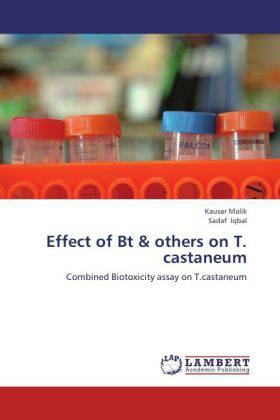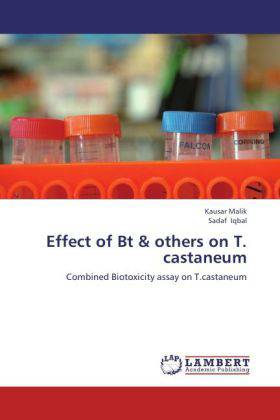
- Afhalen na 1 uur in een winkel met voorraad
- Gratis thuislevering in België vanaf € 30
- Ruim aanbod met 7 miljoen producten
- Afhalen na 1 uur in een winkel met voorraad
- Gratis thuislevering in België vanaf € 30
- Ruim aanbod met 7 miljoen producten
Zoeken
Effect of Bt & others on T. castaneum
Combined Biotoxicity assay on T.castaneum
Kausar Malik, Sadaf Iqbal
Paperback | Engels
€ 58,45
+ 116 punten
Omschrijving
Microbial control of insect pest of crops using entomopathogens is pest management strategy. Bacillus thuringiensis has a great potential for this purpose. The focus of the present study was to determine the individual and combined effect of different insecticides such as Saraca indica as a botanical insecticide, B. thuringiensis and chemical insecticides against larvae and adults of T. castaneum. Results were analyzed by SPSS probit analysis, LC50 was noted for all these insecticides and results were compared with each other. According to the results from the individual insecticide B. thuringiensis show high mortality with harmless effect to environment. Synergistic effect with high mortality rate was observed at 24 to 48 h, for both larvae and adults of T. castaneum. From the study it was observed that mortality rate increases as the concentrations increases, and larvae show higher mortality because they were more susceptible to these insecticides as compared to adults. Percentage mortality of T. castaneum in combined bioassay sodium citrate, S. indica, B. thuringiensis and Bifenthrin+cypermethrin was compared with the mortality of individual insecticides. 61% larvae & 55% adults
Specificaties
Betrokkenen
- Auteur(s):
- Uitgeverij:
Inhoud
- Aantal bladzijden:
- 128
- Taal:
- Engels
Eigenschappen
- Productcode (EAN):
- 9783659232664
- Verschijningsdatum:
- 6/09/2012
- Uitvoering:
- Paperback
- Formaat:
- Trade paperback (VS)
- Afmetingen:
- 152 mm x 229 mm
- Gewicht:
- 199 g

Alleen bij Standaard Boekhandel
+ 116 punten op je klantenkaart van Standaard Boekhandel
Beoordelingen
We publiceren alleen reviews die voldoen aan de voorwaarden voor reviews. Bekijk onze voorwaarden voor reviews.











